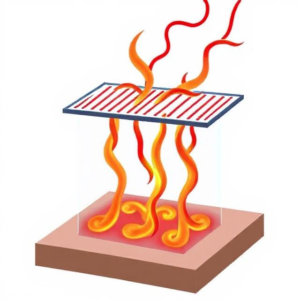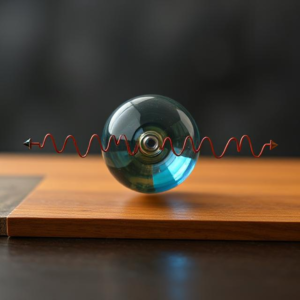Heat Conduction and Diffusion: Explained Simply
Heat conduction is the process by which heat moves from one part of a material to another, or from one material to another, without the material itself moving. In simple terms, it’s how heat travels through objects.

How Does Heat Conduction Work?
- Atoms and Molecules in Motion:
- Everything is made up of atoms and molecules, and they are always moving. When you heat one part of an object, the atoms and molecules in that part start moving faster (because they gain energy).
- Transfer of Energy:
- These faster-moving atoms and molecules collide with their neighbors, passing on the heat energy. This is how heat spreads from the hot part to the cooler part of the object.
- Direction of Heat Flow:
- Heat always moves from the hotter area to the cooler area. This is why when you put a metal spoon in a hot cup of coffee, the spoon starts to get hot — heat flows from the coffee to the spoon.
Example:
Think of a metal rod: If you heat one end of the rod, the heat will travel to the other end, making it warm too. The reason is that the atoms at the hot end start vibrating faster, and their energy is passed on to atoms further down the rod. This is heat conduction.
Key Points:
- Heat conduction happens in solids (like metal, wood, or glass), and it’s how heat moves through them.
- The faster the atoms move, the better the material is at conducting heat.
- Materials like metal are good conductors because their atoms are closely packed, so heat can transfer quickly.
- Insulators, like rubber or wood, don’t conduct heat well because their atoms are not as tightly packed.
Mathematical Formula for Heat Conduction:
The rate of heat flow through a material can be calculated using Fourier’s Law:
- Q = Amount of heat transferred.
- k = Thermal conductivity of the material (how well the material conducts heat).
- A = Area through which heat is flowing.
- ΔT = Temperature difference between the two ends.
- L = Thickness of the material.
Diffusion:
Diffusion is the process by which particles (like atoms, molecules, or even small objects) move from a region of higher concentration to a region of lower concentration. It’s how substances spread out and mix without any external force.
How Does Diffusion Work?
- Movement of Particles:
- In any substance (gas, liquid, or solid), particles are always moving, even if you can’t see it. When particles are in a region where they are crowded (high concentration), they naturally move to areas where there are fewer particles (low concentration) to spread out more evenly.
- No Need for External Energy:
- Diffusion happens naturally because of the random movement of particles. It doesn’t require extra energy. For example, when you open a perfume bottle in one corner of a room, the scent particles spread out and eventually fill the entire room.
Example:
Think about a drop of ink in water. The ink particles start in one place (high concentration), and over time, they spread out throughout the water, making the entire glass of water colored. This is diffusion.
Key Points:
- Diffusion happens in gases, liquids, and solids.
- It’s driven by the random movement of particles.
- In gases, diffusion happens quickly because gas particles move faster. In liquids and solids, diffusion is slower because the particles are more tightly packed.
- Temperature can affect diffusion. The higher the temperature, the faster the particles move, so diffusion happens more quickly.
Mathematical Formula for Diffusion:
Diffusion can be described using Fick’s Law:
- J = Diffusion flux (how much substance is moving through a given area).
- D = Diffusion coefficient (how easily the particles diffuse).
- dC/dx = The concentration gradient (how much the concentration changes over a distance).
Key Differences Between Heat Conduction and Diffusion:
- Heat conduction deals with the transfer of thermal energy (heat) through a material from a hotter area to a cooler area.
- Diffusion is about the movement of particles from an area of high concentration to low concentration. It can happen in any type of substance (solid, liquid, or gas).
Real-Life Examples:
- Heat Conduction:
- When you heat one end of a metal rod, the heat travels to the other end.
- Cooking: A frying pan gets hot from the stove, and heat moves through the metal to cook the food.
- Diffusion:
- When you open a perfume bottle, the scent diffuses into the air.
- Sugar in tea: If you stir sugar in your tea, the sugar particles diffuse through the liquid.
Summary:
- Heat conduction is how heat moves through materials, like when a metal rod gets hot from one end to the other.
- Diffusion is how particles move from high concentration to low concentration, like when ink spreads in water or perfume fills a room.
In Simple Terms:
- Heat conduction: Heat flows from hot to cold places in materials (like metal or water).
- Diffusion: Particles move from crowded places to empty spaces, like how a perfume scent spreads.











